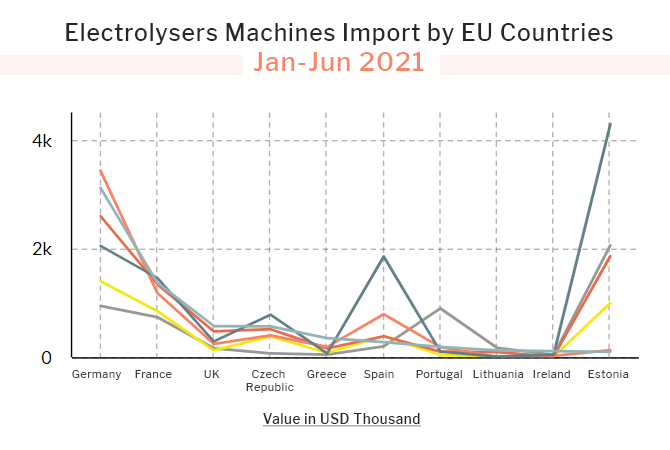Key Highlights:
- EU set a target to produce 50% green hydrogen from renewable power
- “Fit for 55” proposal also aims to generate 40-GW electrolyser capacity by 2030
- EU and China are the biggest competitors in green hydrogen industry
The European Union has set a target to cut 55% greenhouse gas emissions by 2030 under its “Fit for 55” proposal. It will impose new laws across numerous sectors to achieve this target. The EU also aims to generate 40-GW electrolyser capacity, producing 10 million MT/year of green hydrogen. The European Commission’s 2030 green hydrogen targets will require huge amounts of renewable power generation.
EU’s Fit for 55 Proposal
The European Commission has released its “Fit for 55” legislation package, supporting its commitment to reduce net greenhouse gas emissions by at least 55% by 2030. Market research reports show EU needs around 11 million MT/year of hydrogen to meet the demand targets, with around 5.2 million MT going to industries and 5.8 million MT to transport.
However, the nature of targeted sectors means much of the hydrogen will need to be converted to ammonia. That would lead to large conversion losses, less use of final energy and the need for higher input volumes.
Market intelligence data shows EU industrial sector hydrogen demand is currently around 10 million MT/year, with 45% for refining, 38% for ammonia production and 8% for methanol. In transport, hydrogen is required in the maritime and aviation sectors, where there is limited potential for direct electrification.
EU Plans
Questions have been raised over how the EU will reach the renewable hydrogen target by 2030, given the utilisation rate limitations of running electrolysers from renewables and large amounts of power needed for green hydrogen production. The EU has also set a 40-GW electrolyser capacity target by 2030. The EU is focused on requirements that green hydrogen must be produced from additional renewable power or by curtailing existing capacity.
Electrolysis is a promising option for producing carbon-free hydrogen by using renewable and nuclear resources. Machines are used for electrolysis that European Union imports from the world countries. Germany is the biggest importer of electrolysis machines, followed by France, the United Kingdom, the Czech Republic and Greece. Germany imported electrolysis worth USD 3,107 thousand in June 2021 and France imported the product valued at USD 1,370 thousand. Look at the data visualisation of the EU’s top 10 importing countries of electrolysers with dollar amounts recorded during Jan-Jun 2021.

EU and China in Green Hydrogen Industry – Competitive Analysis
The commercial rivalry between Europe and China could force prices of green hydrogen down rapidly. According to market research experts, competition in green hydrogen technology between Europe and China will be crucial to kick start a global hydrogen economy because it will drive down the cost of the technology.
Within the European Union, Germany is majorly focused to produce green hydrogen. The country boasts strong electrolyser manufacturers and many suppliers & engineering companies have high hopes of producing key components in order to contribute to technological development. By 2030, the EU targets to produce 10 million tonnes of green hydrogen with a combined electrolyser capacity of 40 GW. In its own national strategy, Germany set a target of 5 GW.
Chinese manufacturers are ahead of European countries in manufacturing low-cost green hydrogen production machines as their electrolysers currently cost only a fraction of European ones. China is a major green hydrogen competitor because the country established it early on as a core element of its climate plan.
Green Hydrogen Is Still Too Expensive
Green hydrogen is more expensive than the conventional variety made from fossil fuels. That is because the equipment used to produce renewable hydrogen is costly and the production process requires huge amounts of power. As a result, private companies currently have no incentives to produce renewable electricity in large amounts.
Will the EU achieve its target to cut greenhouse gas emissions by 50% and 40-GW electrolyser capacity by 2030? It will be a big challenge for European Union countries as renewable power will cost more than traditional ones. And if that is accomplished, it will benefit the global environment as the world nations are coping up with climate change.



